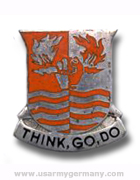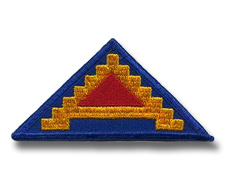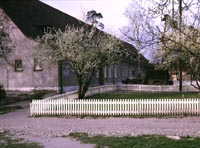| If you do
NOT see the Table of Contents frame to the left of this page, then
Click here to open 'USArmyGermany' frameset |
|||||||||||||||||||||
|
504th
Signal Battalion |
|||||||||||||||||||||
|
|
|||||||||||||||||||||
|
|||||||||||||||||||||
|
|
|||||||||||||||||||||
| Battalion History | |||||||||||||||||||||
 504th Signal Bn DUI
504th Signal Bn DUI |
|||||||||||||||||||||
| (Source: Email from Kendall Fugate, 93rd Sig Bn and 504th Sig Bn, 1961-1964) | |||||||||||||||||||||
| I and several
other newly minted 2LTs joined the 93rd Signal Battalion
at Ft. Huachuca, AZ in May 1961, fresh from the Signal Officer Basic
Course at Ft. Monmouth. The battalion was commanded by LTC Zellerfrow
(sp?). For two days I was assigned to B Company under CPT Bailey,
who was very proud of his pistol marksmanship, and then transferred
to A Company under CPT Ray Martel, who called everyone “stud.” I was responsible for the Carrier Platoon, and reported to 1LT Chris Larson. Everyone was new, the concepts were new, and the equipment was mostly untried in the shelter mounted configurations we were given. Planning and control were worked out (when they worked at all) on the fly. Since I had worked several summers for the phone company, I found the lack of workable standard operating practices appalling. We did our best to make the theory work in practice, and passed the summer fighting wildfires, training and struggling through two training tests. In August we were placed on orders for Germany. After we packed and loaded the equipment, most of us were allowed to take leave and make our own way to Charleston, SC to board a troopship, the USNS Darby for the trip to Bremerhaven and an overnight train to Hanau. There we were met by the advance party, which had picked up our equipment in France. Shortly after arriving, some of the officers were reassigned by 7th Army to fill out other newly arriving units. I was reassigned to the 504th Signal Battalion in Mannheim, where I was detailed to be OIC of a Signal supply and maintenance direct support unit in Kaiserslautern. I did manage to remain in touch with many of my friends in the 93rd until I finished my tour in 1964. The 504th Signal Battalion (Army Supply & Maintenance) was formed in 1961 from a number of company and detachment sized maintenance units already in Germany, which reported to the 7th Army Signal Officer, and a headquarters company deployed from CONUS. The battalion was organized under the 505th Signal Group. During the buildup of combat and signal units through 1961, a number of officers, myself included, were reassigned from incoming communications battalions to populate the battalion's 10-12 direct support detachments (DSUs) and staff positions. |
|||||||||||||||||||||
| ORGANIZATION (1962): | |||||||||||||||||||||
|
|||||||||||||||||||||
| After I returned
to CONUS in 1964, the battalion was reorganized and redesignated as
part of the Army's reorganization of logistics support. There is a 504th website: http://www.freewebs.com/504thsignal/index.htm A Also, there were a number of attached Signal support companies which rotated between CONUS and 7th Army in the '60s. I had the honor of commanding one of them and taking it to RVN in 1966. |
|||||||||||||||||||||
| If you have more
information on the history or organization of the 504th Signal Battalion,
please contact me |
|||||||||||||||||||||
|
|
|||||||||||||||||||||
| 1962 | |||||||||||||||||||||
| (Source: Email from Roman P. Weber) | |||||||||||||||||||||
| I was transferred for Co. B, 93rd Sig BN, Hanau, to Co. C, 504th Sig BN, Kornwestheim, in 1962. Co. C, Sig Depot, Supply and Depot 4th echelon Sig Maint was in nearby Ludwigsburg. I was SP5 in charge of depot Fld Rdo Repair, Rebuild, or classifying uneconomically repairable fld radios such as, AN/PRC-10, AN/GRC and VRC Radio Set components, ANTRC-24, component xmtr recvrs of AN/MRC54, 69 & 73. -- Owning units of equipment, 2nd echelon maint at BNs etc, sent equipment to DS maint facilities of Div Ord etc, 3rd echelon. 3rd echelon would then submit equip they couldn't repair or not authorized to requisition parts from -35P TM parts publications. Co. C Depot Maint when classified a radio "uneconomically repairable" would DX the radio component xmtr/rcvr for one in stock (new or rebuilt) like set. DA Form 2407, Work Request would note one set DX's for another like set and would be authority for owning unit to change Serial Number for accountabiltiy. -- Unserviceable classified radios would be cannibalized for parts. We had a separate parts room where cannibalized parts were stocked. If the part needed to repair a radio was not on hand otherwise and we didn't want to wait for parts to come in (weeks sometimes) thru normal supply channels, we would use cannibalized parts. Co. C was divided into two. One part the troops that worked in repair maint and the others that worked in our supply warehouse next door. When we requisition parts, the req'n had to go thru normal channels and would eventually end up at our supply warehouse next to our repair bldg. Even though we knew that supply had needed repair parts next door, we weren't permitted to go there and get them. -- I knew an SP5 that worked in supply. Lots of times I would have him look up if they had some parts in stock that we needed. He almost always would figure out a way (technically illegally) and get me the parts I asked for. 7th Army received one of the best Amateur Xmtr-Rcvr sets, KWM-2A, for installation in high ranking staff cars and on the Army train connected to Bremerhaven. For years I had German Amateur licences (DL4RK & DL5AY). The WO in charge of depot, my immediate supervisor, switched me over to doing nothing other than installing KWM-2s in staff cars and in the train. I think Co. C, 504th was the only facility in S. Command that had that mission. I had no "helpers." Along with issue of KWM-2s to the Depot was included about every component part of the KWM-2, other than the main chassis. We had more of the radios than needed for installations. If for example a general's staff car came in with radio inoperative and I couldn't determine immediately some minor repair needed, I would DX his with another one from stock of KWM-2s I had. -- C Company Cmdr was also the Depot Cmdr. Cpt Thoms. WOinC of depot, my supervisor, WO Reha (spelling?). I think name of our kaserne at Kornwestheim was, Ludendorff Kaserne. Small place with only a few barracks of Engineers. Engrs made the military maps for Germany from aerial photos. The 1st/sgt there was a "drinking buddy" of mine and gave me a tour of the place as to how military maps are made. Very interesting. -- The kaserne at Kornwestheim had only one small club shared by EM and also officers if they wanted to drink there. It was up above the small snack bar there. Live-music weekends. GI bands. We could bring frauleins to the club. Did. There were known occassions when fraulein ended up spending the night with some GI in the barracks. I personally know that for a fact! HQ, 504th was at Sullivan Brks, Mannheim. I left Germany for the States from there. 10+ years since my first tour of Germany with 334th ASA C/R Company began in 1952 at Funari Bks, Mannheim (Kafertal), about 10 minute walk from Sullivan Bks. It's been a long time ago, 1963, when I was with Co C, 504th Kornwestheim Kaserne. I seem to recall that over the gate it said, "Home of the Engineers." |
|||||||||||||||||||||
| 1965 | |||||||||||||||||||||
| (Source: Email from John Ballard, Det 2, Co "C" 504th Sig Bn, 1965) | |||||||||||||||||||||
(John has also provided comments on his assignments to Co "D," 71st Maint Bn and the 66th Maint Bn) Det 2 was commanded by CW2 Stovall and the Detachment NCOIC was SFC (E6) Schwartz. My supervisor was SP4 Klaus Muller (he was from Nuernberg and was allowed to live off post with his mother). My co-worker was PFC Jules Ducharme. We worked in the building (opposite arm of the H that housed the Bowling Alley) across from the Mess Hall. We had three trailers backed against three windows in the building that held most of our Signal Supply Stockage. In the next room of this building housed our signal repair facility. There was also a Detachment 3 that was located in Vilseck. This detachment had an NCOIC, SP5 “Val” Varela. They drew support from us due to proximity. I had several additional duties while there. I was primary operator of C-13, an M-37B (it took two men and a boy to open the drivers door from the inside). I was also assigned as a team member on a 3.5 Rocket Launcher. Many stories could be told about my six months in this detachment; one, I was actually kicked out of the EM Club for being too young once. I didn’t turn 18 until March of 1965. When I arrived at Merrell Barracks (Det 2, 504th Sig Bn) in 1965 the Aviation Section of the 2nd ACR operated at an airfield in the vicinity of Soldiers Field (access was through Soldiers Field along side the Dutzendeich). They had a control tower van, the runway ran almost parallel to Regensburger Strasse towards what is now Langwasser.
Organizational aircraft were H-13, CH-34 and I believe an O-1. I think there were one or two OV-1's attached. The ammo dump was next to the airfield in the direction of Langwasser. I think they moved to Feucht in 1967 and started receiving the UH-1 to replace their CH-34's. I was later assigned to the 2nd ACR in 1975 (Air Cav Troop) but that is another story. John Ballard
|
|||||||||||||||||||||
|
|
|||||||||||||||||||||
| Related Links: |
|||||||||||||||||||||






